check engine YAMAHA YZF-R6 2012 Owner's Manual
[x] Cancel search | Manufacturer: YAMAHA, Model Year: 2012, Model line: YZF-R6, Model: YAMAHA YZF-R6 2012Pages: 112, PDF Size: 2.46 MB
Page 72 of 112
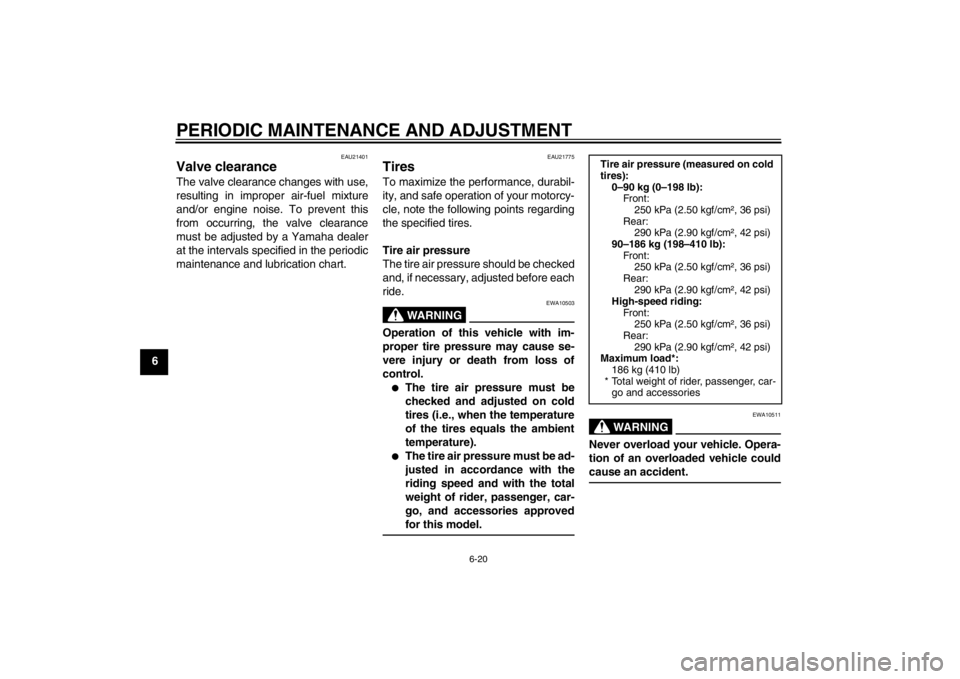
PERIODIC MAINTENANCE AND ADJUSTMENT
6-20
6
EAU21401
Valve clearance The valve clearance changes with use,
resulting in improper air-fuel mixture
and/or engine noise. To prevent this
from occurring, the valve clearance
must be adjusted by a Yamaha dealer
at the intervals specified in the periodic
maintenance and lubrication chart.
EAU21775
Tires To maximize the performance, durabil-
ity, and safe operation of your motorcy-
cle, note the following points regarding
the specified tires.
Tire air pressure
The tire air pressure should be checked
and, if necessary, adjusted before each
ride.
WARNING
EWA10503
Operation of this vehicle with im-
proper tire pressure may cause se-
vere injury or death from loss of
control.●
The tire air pressure must be
checked and adjusted on cold
tires (i.e., when the temperature
of the tires equals the ambient
temperature).
●
The tire air pressure must be ad-
justed in accordance with the
riding speed and with the total
weight of rider, passenger, car-
go, and accessories approved
for this model.
WARNING
EWA10511
Never overload your vehicle. Opera-
tion of an overloaded vehicle could
cause an accident.Tire air pressure (measured on cold
tires):0–90 kg (0–198 lb):Front:
250 kPa (2.50 kgf/cm², 36 psi)
Rear: 290 kPa (2.90 kgf/cm², 42 psi)
90–186 kg (198–410 lb): Front:250 kPa (2.50 kgf/cm², 36 psi)
Rear: 290 kPa (2.90 kgf/cm², 42 psi)
High-speed riding:
Front:250 kPa (2.50 kgf/cm², 36 psi)
Rear:
290 kPa (2.90 kgf/cm², 42 psi)
Maximum load*: 186 kg (410 lb)
* Total weight of rider, passenger, car- go and accessories
U1JSE0E0.book Page 20 Wednesday, July 27, 2011 10:34 AM
Page 81 of 112
![YAMAHA YZF-R6 2012 Owners Manual PERIODIC MAINTENANCE AND ADJUSTMENT
6-29
6
may contain substances that
could damage the O-rings.
[ECA11111]
EAU23095
Checking and lubricating the
cables The operation of all control cables and
the co YAMAHA YZF-R6 2012 Owners Manual PERIODIC MAINTENANCE AND ADJUSTMENT
6-29
6
may contain substances that
could damage the O-rings.
[ECA11111]
EAU23095
Checking and lubricating the
cables The operation of all control cables and
the co](/img/51/54369/w960_54369-80.png)
PERIODIC MAINTENANCE AND ADJUSTMENT
6-29
6
may contain substances that
could damage the O-rings.
[ECA11111]
EAU23095
Checking and lubricating the
cables The operation of all control cables and
the condition of the cables should be
checked before each ride, and the ca-
bles and cable ends should be lubricat-
ed if necessary. If a cable is damaged
or does not move smoothly, have a
Yamaha dealer check or replace it.
WARNING! Damage to the outer
housing of cables may result in in-
ternal rusting and cause interfer-
ence with cable movement. Replace
damaged cables as soon as possi-
ble to prevent unsafe conditions.[EWA10711] EAU23114
Checking and lubricating the
throttle grip and cable The operation of the throttle grip should
be checked before each ride. In addi-
tion, the cable should be lubricated by a
Yamaha dealer at the intervals speci-
fied in the periodic maintenance chart.
The throttle cable is equipped with a
rubber cover. Make sure that the cover
is securely installed. Even though the
cover is installed correctly, it does not
completely protect the cable from water
entry. Therefore, use care not to pour
water directly onto the cover or cable
when washing the vehicle. If the cable
or cover becomes dirty, wipe clean with
a moist cloth.
Recommended lubricant:
Yamaha Chain and Cable Lube or
engine oil
U1JSE0E0.book Page 29 Wednesday, July 27, 2011 10:34 AM
Page 84 of 112
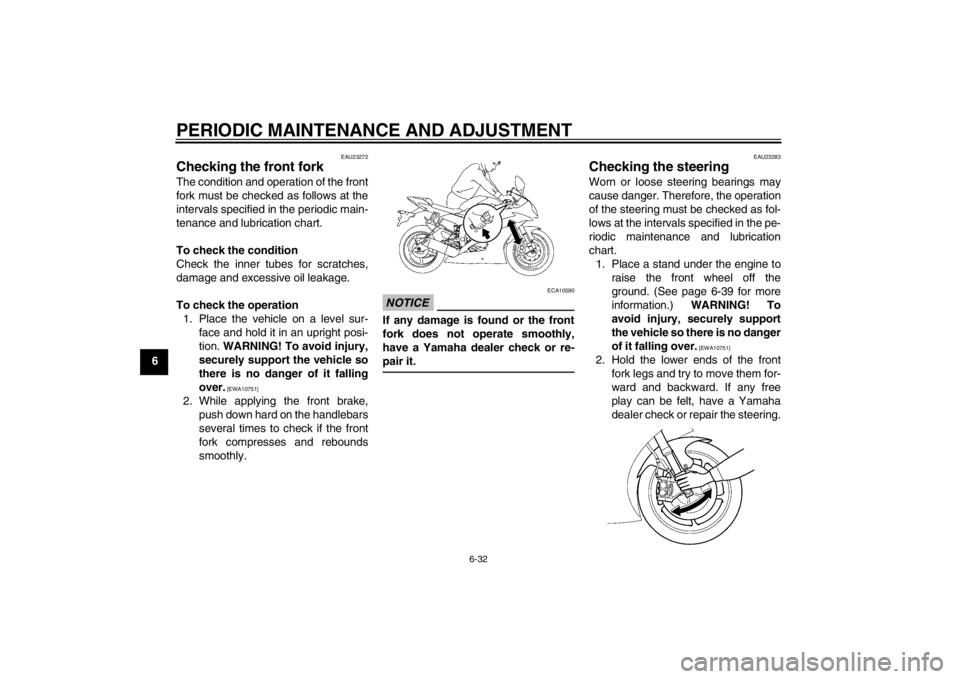
PERIODIC MAINTENANCE AND ADJUSTMENT
6-32
6
EAU23272
Checking the front fork The condition and operation of the front
fork must be checked as follows at the
intervals specified in the periodic main-
tenance and lubrication chart.
To check the condition
Check the inner tubes for scratches,
damage and excessive oil leakage.
To check the operation1. Place the vehicle on a level sur- face and hold it in an upright posi-
tion. WARNING! To avoid injury,
securely support the vehicle so
there is no danger of it falling
over.
[EWA10751]
2. While applying the front brake, push down hard on the handlebars
several times to check if the front
fork compresses and rebounds
smoothly.
NOTICE
ECA10590
If any damage is found or the front
fork does not operate smoothly,
have a Yamaha dealer check or re-
pair it.
EAU23283
Checking the steering Worn or loose steering bearings may
cause danger. Therefore, the operation
of the steering must be checked as fol-
lows at the intervals specified in the pe-
riodic maintenance and lubrication
chart.1. Place a stand under the engine to raise the front wheel off the
ground. (See page 6-39 for more
information.) WARNING! To
avoid injury, securely support
the vehicle so there is no danger
of it falling over.
[EWA10751]
2. Hold the lower ends of the front fork legs and try to move them for-
ward and backward. If any free
play can be felt, have a Yamaha
dealer check or repair the steering.
U1JSE0E0.book Page 32 Wednesday, July 27, 2011 10:34 AM
Page 91 of 112
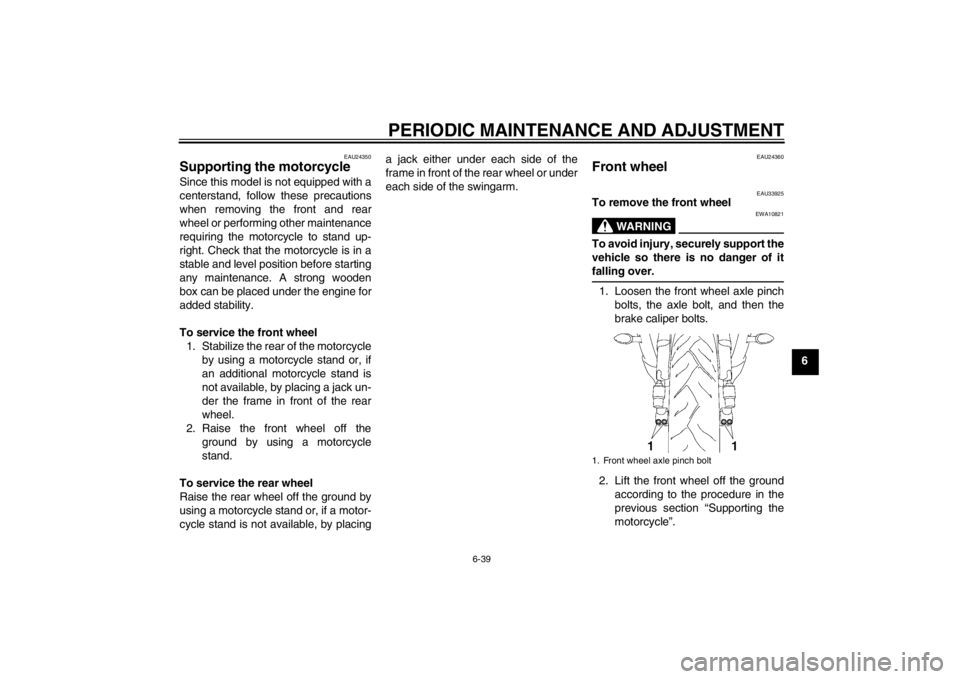
PERIODIC MAINTENANCE AND ADJUSTMENT
6-39
6
EAU24350
Supporting the motorcycle Since this model is not equipped with a
centerstand, follow these precautions
when removing the front and rear
wheel or performing other maintenance
requiring the motorcycle to stand up-
right. Check that the motorcycle is in a
stable and level position before starting
any maintenance. A strong wooden
box can be placed under the engine for
added stability.
To service the front wheel1. Stabilize the rear of the motorcycle by using a motorcycle stand or, if
an additional motorcycle stand is
not available, by placing a jack un-
der the frame in front of the rear
wheel.
2. Raise the front wheel off the ground by using a motorcycle
stand.
To service the rear wheel
Raise the rear wheel off the ground by
using a motorcycle stand or, if a motor-
cycle stand is not available, by placing a jack either under each side of the
frame in front of the rear wheel or under
each side of the swingarm.
EAU24360
Front wheel
EAU33925
To remove the front wheel
WARNING
EWA10821
To avoid injury, securely support the
vehicle so there is no danger of it
falling over.1. Loosen the front wheel axle pinch
bolts, the axle bolt, and then the
brake caliper bolts.
2. Lift the front wheel off the ground according to the procedure in the
previous section “Supporting the
motorcycle”.1. Front wheel axle pinch bolt
U1JSE0E0.book Page 39 Wednesday, July 27, 2011 10:34 AM
Page 97 of 112

PERIODIC MAINTENANCE AND ADJUSTMENT
6-45
6
EAU42503
Troubleshooting charts Starting problems or poor engine performance
Check the fuel level in
the fuel tank.1. Fuel
There is enough fuel.There is no fuel.
Check the compression.
Supply fuel.
The engine does not start.
Check the compression.
Operate the electric starter.2. Compression
There is compression.
There is no compression.
Check the ignition. Have a Yamaha dealer
check the vehicle.
Remove the spark plugs
and check the electrodes.3. Ignition
Wipe off with a dry cloth and correct the
spark plug gaps, or replace the spark plugs.
Have a Yamaha dealer check the vehicle.
The engine does not start.
Have a Yamaha dealer
check the vehicle.
The engine does not start.
Check the battery.
Operate the electric starter.4. Battery
The engine turns over
quickly.
The engine turns over
slowly.
The battery is good.Check the battery lead connections,
and have a Yamaha dealer charge
the battery if necessary.
DryWet
Operate the electric starter.
U1JSE0E0.book Page 45 Wednesday, July 27, 2011 10:34 AM
Page 98 of 112
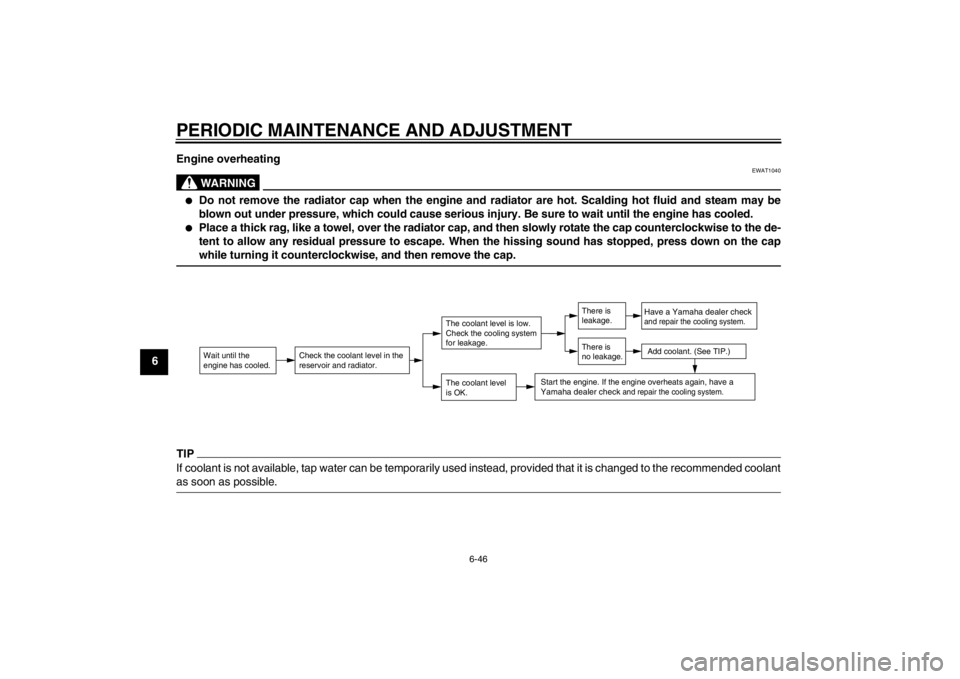
PERIODIC MAINTENANCE AND ADJUSTMENT
6-46
6Engine overheating
WARNING
EWAT1040
●
Do not remove the radiator cap when the engine and
radiator are hot. Scalding hot fluid and steam may be
blown out under pressure, which could cause serious injury. Be sure to wait until the engine has cooled.
●
Place a thick rag, like a towel, over the radiator cap, and then slowly rotate the cap counterclockwise to the de-
tent to allow any residual pressure to escape. When the hissing sound has stopped, press down on the cap
while turning it counterclockwise, and then remove the cap.
TIPIf coolant is not available, tap water can be temporarily used instead, provided that it is changed to the recommended coolant
as soon as possible.
Wait until the
engine has cooled.
Check the coolant level in the
reservoir and radiator.
The coolant level
is OK.The coolant level is low.
Check the cooling system
for leakage.
Have a Yamaha dealer checkand repair the cooling system.Add coolant. (See TIP.)
Start the engine. If the engine overheats again,
have a
Yamaha dealer check
and repair the cooling system.
There is
leakage.
There is
no leakage.
U1JSE0E0.book Page 46 Wednesday, July 27, 2011 10:34 AM
Page 102 of 112
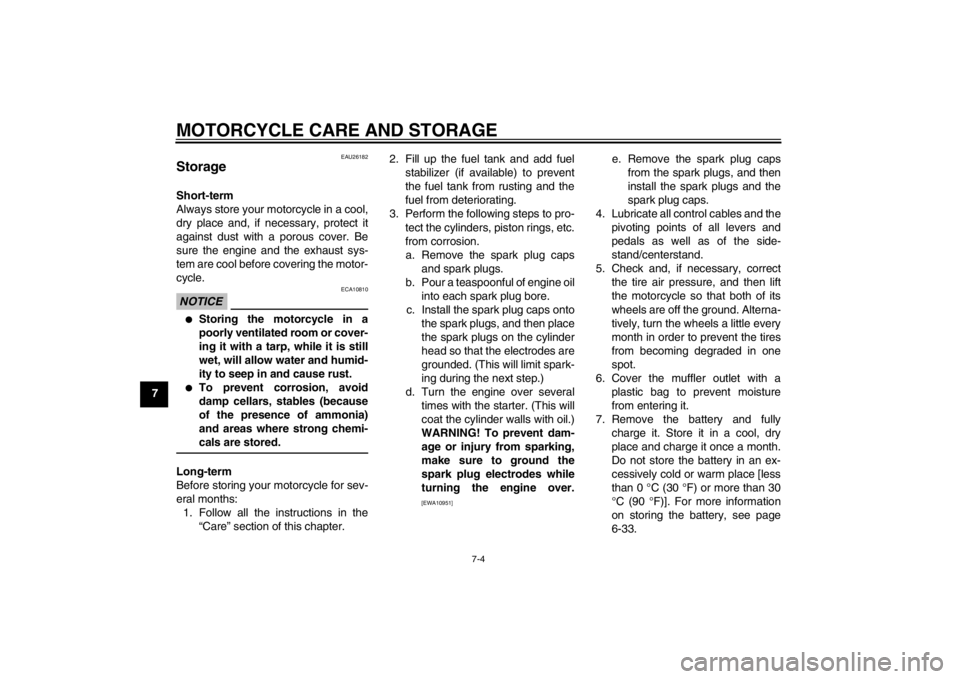
MOTORCYCLE CARE AND STORAGE
7-4
7
EAU26182
Storage Short-term
Always store your motorcycle in a cool,
dry place and, if necessary, protect it
against dust with a porous cover. Be
sure the engine and the exhaust sys-
tem are cool before covering the motor-
cycle.NOTICE
ECA10810
●
Storing the motorcycle in a
poorly ventilated room or cover-
ing it with a tarp, while it is still
wet, will allow water and humid-
ity to seep in and cause rust.
●
To prevent corrosion, avoid
damp cellars, stables (because
of the presence of ammonia)
and areas where strong chemi-
cals are stored.
Long-term
Before storing your motorcycle for sev-
eral months:1. Follow all the instructions in the “Care” section of this chapter. 2. Fill up the fuel tank and add fuel
stabilizer (if available) to prevent
the fuel tank from rusting and the
fuel from deteriorating.
3. Perform the following steps to pro- tect the cylinders, piston rings, etc.
from corrosion.a. Remove the spark plug caps and spark plugs.
b. Pour a teaspoonful of engine oil into each spark plug bore.
c. Install the spark plug caps onto the spark plugs, and then place
the spark plugs on the cylinder
head so that the electrodes are
grounded. (This will limit spark-
ing during the next step.)
d. Turn the engine over several times with the starter. (This will
coat the cylinder walls with oil.)
WARNING! To prevent dam- age or injury from sparking,
make sure to ground the
spark plug electrodes while
turning the engine over.
[EWA10951]
e. Remove the spark plug caps from the spark plugs, and then
install the spark plugs and the
spark plug caps.
4. Lubricate all control cables and the pivoting points of all levers and
pedals as well as of the side-
stand/centerstand.
5. Check and, if necessary, correct the tire air pressure, and then lift
the motorcycle so that both of its
wheels are off the ground. Alterna-
tively, turn the wheels a little every
month in order to prevent the tires
from becoming degraded in one
spot.
6. Cover the muffler outlet with a plastic bag to prevent moisture
from entering it.
7. Remove the battery and fully charge it. Store it in a cool, dry
place and charge it once a month.
Do not store the battery in an ex-
cessively cold or warm place [less
than 0 °C (30 °F) or more than 30
°C (90 °F)]. For more information
on storing the battery, see page
6-33.
U1JSE0E0.book Page 4 Wednesday, July 27, 2011 10:34 AM
Page 108 of 112

INDEXAAir filter element .................................... 6-19
Anti-theft alarm (optional)...................... 3-14
Auxiliary light ......................................... 6-38BBattery................................................... 6-33
Brake and clutch levers, checking and lubricating ..................... 6-30
Brake and shift pedals,
checking and lubricating ..................... 6-30
Brake fluid, changing ............................ 6-26
Brake fluid level, checking .................... 6-25
Brake lever ............................................ 3-16
Brake lever free play, checking ............. 6-23
Brake light switches .............................. 6-24
Brake pedal ........................................... 3-17CCables, checking and lubricating .......... 6-29
Care ........................................................ 7-1
Catalytic converters .............................. 3-19
Clutch lever ........................................... 3-15
Clutch lever free play, adjusting ............ 6-23
Coolant.................................................. 6-16
Coolant temperature warning light .......... 3-5
Cowlings and panels, removing and installing ......................... 6-8DDimmer switch ...................................... 3-14
Drive chain, cleaning and lubricating .... 6-28
Drive chain slack ................................... 6-27EEngine break-in ....................................... 5-3
Engine idling speed, checking .............. 6-19
Engine oil and oil filter cartridge ............ 6-13 Engine stop switch................................ 3-15
Engine trouble warning light ................... 3-7
EXUP system ....................................... 3-28
FFront and rear brake pads, checking .... 6-24
Front fork, adjusting .............................. 3-22
Front fork, checking .............................. 6-32
Fuel....................................................... 3-18
Fuel consumption, tips for reducing........ 5-3
Fuel level warning light ........................... 3-4
Fuel tank breather hose and
overflow hose ..................................... 3-19
Fuel tank cap ........................................ 3-17
Fuses, replacing ................................... 6-34HHandlebar switches .............................. 3-14
Hazard switch ....................................... 3-15
Headlight bulb, replacing ...................... 6-35
Helmet holding cable ............................ 3-21
High beam indicator light ........................ 3-4
Horn switch ........................................... 3-15IIdentification numbers ............................ 9-1
Ignition circuit cut-off system ................ 3-29
Immobilizer system ................................. 3-1
Immobilizer system indicator light........... 3-7
Indicator lights and warning lights .......... 3-4LLicense plate light bulb, replacing ........ 6-38
Luggage strap holders .......................... 3-27MMain switch/steering lock........................ 3-2
Maintenance and lubrication, periodic .... 6-4 Maintenance,
emission control system ....................... 6-3
Matte color, caution ................................. 7-1
Model label .............................................. 9-1
Multi-function meter unit .......................... 3-8
NNeutral indicator light .............................. 3-4OOil level warning light .............................. 3-4PParking .................................................... 5-4
Part locations .......................................... 2-1
Pass switch ........................................... 3-14RRear view mirrors .................................. 3-22SSafety information ................................... 1-1
Seats ..................................................... 3-20
Shifting .................................................... 5-2
Shift pedal ............................................. 3-16
Shift timing indicator light ........................ 3-7
Shock absorber assembly, adjusting .... 3-25
Sidestand .............................................. 3-28
Sidestand, checking and lubricating...... 6-31
Spark plugs, checking ........................... 6-12
Specifications .......................................... 8-1
Starting the engine .................................. 5-1
Start switch............................................ 3-15
Steering, checking................................. 6-32
Storage.................................................... 7-4
Supporting the motorcycle .................... 6-39
Swingarm pivots, lubricating ................. 6-31TTail/brake light ....................................... 6-37
U1JSE0E0.book Page 1 Wednesday, July 27, 2011 10:34 AM